Today Singapore trade finance startup #dltledgers announced a US$7 million Series A raise and simultaneously said it’s switching enterprise blockchain technologies from Hyperledger Fabric to R3’s Corda. We asked whether R3 or its directors invested in the Series A but received a ‘no comment’ response.
The funding was led by India’s Regis and Savoy, Vittal, and existing investor Walden International. It follows a previous $2.5 million seed raise from Walden International.
As of five months ago, #dltledgers reported SGD3 billion ($2.22 billion) in trade transactions and today said it had more than 200% YoY growth but did not provide specific figures.
The company boasts numerous corporate clients, including Shiseido, Wilmar, Mitsui, Wipro Unza, Vertiv, and Schneider Electric as well as more than 500 SMEs. It also claims more than 45 banks as platform users, including ANZ, DBS, Standard Chartered Bank, and Rabobank.
While #dltledgers may be a startup, to our knowledge, it has significantly more traction than the very well-funded Corda trade finance consortia platforms Marco Polo and Contour. Although in fairness, Contour only recently went into production.
Hence this is a big win for R3. “We are ecstatic that one of the world’s fastest-growing trade digitisation platforms is moving to Corda,” said R3’s CEO David Rutter.
For Hyperledger, #dltledgers was an important early case study. It’s not the first platform to switch to Corda. Two years ago, fraud mitigation platform MonetaGo made the same switch. It provides a trade finance anti-fraud solution with very significant traction in India, and was adopted by SWIFT India.
In mid-2018, other high profile switches to Corda were the two big insurance consortia, B3i (from Fabric) and RiskStream (from Ethereum). However, RiskStream (formerly RiskBlock) recently transitioned to the Kaleido platform, which supports both Ethereum and Corda. The reasons for the latest RiskStream switch included speed to production, efficiency, and the ability to offer multiple technology platforms.
#dltledgers founder Samir Neji said, “By migrating our blockchain platform to Corda, the first purpose-built blockchain for enterprise, our current and future clients will benefit from unparalleled security, transparency and performance that comes with Corda.”
He continued, “The injection of funding will help #dltledgers to amplify its work on partnerships, standards, integration, as well as accelerating product development in several areas. One area is Cognitive Document Automation (CDA) — a unique combination of graphical processing, machine learning, and blockchain — further reducing the effort required to reconcile invoices, purchase orders, packing lists, and other trade documents.”
Some questions answered
#dltledgers responded to queries as follows:
1. What was the move to Corda driven by?
The move to Corda was the result of an ongoing discussion on interoperability and how the permissioned frameworks can co-exist. We believe Hyperledger and Corda both have unique strengths and weaknesses – we see advantages of being a platform that can run on both. Making Corda our default platform in the long term is the result of several factors around our specific use cases, particularly where we’re building networks that include both corporates and banks. As you point out, Corda is strong in the FSI space, and we believe this can help us meet our objectives faster. Technically speaking, Corda also offers some advantages in terms of scalability, and the balance between throughput and privacy, and they’re doing some interesting things with identity.
2. How abstracted was the Fabric functionality. ie. how big a task, how long will it take?
Our engineering team has been developing on both platforms for 6 months. This included a re-platforming of our TradeDoc Validation platform (the basis of Singapore’s Trade Finance Registry). This was originally built with Hyperledger but is now also available in Corda. We plan to move to Corda gradually over the next two years, our top priority being to ensure that our customers continue to enjoy the reliability, security, and flexibility they are experiencing currently.
3. Does that mean the Singapore trade registry will migrate? Or is Fabric better for that use case?
Singapore’s Trade Finance Registry was deployed on our TradeDoc Validation Platform. This already runs on Corda and Hyperledger. We are approaching this as a global initiative. Central banks need options, so this platform needs to function in numerous different geographies, use different technologies, and interoperate.
4. Atul Patel has been an active participant in Hyperledger. Will that change?
We believe in continuing to contribute to the open source environment. Atul, and other #dltledgers employees, will continue to provide support. To that end, Atul recently became the chair of Hyperledger’s global interoperability committee.
5. You didn’t include specific trade figures. Can you share any?
I can tell you we’re now well over USD 3bn, but also that this is no longer a KPI we’re tracking. As you know, our networks are private, so we are not party to the data inside. Historically we used to gather this data from our customers and financing partners. With expansion to MENA, ANZ, India, Japan, etc. this is becoming increasingly difficult to track and report. We’re now focused on other metrics, including ACV, ARR, TCV, churn, etc. I’m afraid I can’t share more on those at present.
Having said that, as the article reports, we are experiencing a significant increase in traction. This is driven partly by changing attitudes to digitisation following the pandemic. It’s also partly due to the amazing support we’ve received from the Singapore Government, particularly IMDA, with their drive to help Singapore-based SMEs to create competitive advantage.
Funding valuation gaps
Triterras claims to have processed $8.7 billion in transactions, so it’s maybe a little more than twice as big as #dltledgers in terms of transactions. We don’t know #dltledgers revenues, so it’s not a like-for-like comparison. Both are blockchain trade platforms in the same sector but seem to have dramatically different valuations.
It’s also notable that #dltledgers $7 million funding has been in the works for quite a while. In the meantime, another Singapore trade finance platform Triterras listed through a SPAC, at one point achieving unicorn status. However, its market capitalization is currently below $600 million and it ran into some controversy. It uses alternative funding sources rather than banks.
Updates: the article has been updated to include the answers to question from #dltledgers and the no comment response from R3 about whether the company or its directors invested in #dltledgers






